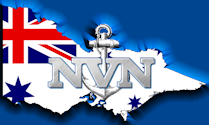Admiral Sir Victor Alfred Trumper Smith AC KBE CB DSC RAN
Born 1913 – Died 1998
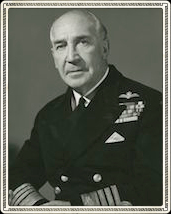 Victor
Smith was born on 9 May 1913 at Chatswood, NSW, to George
and Una Smith (nee Trumper). He was the
second of three children and christened Victor Alfred
Trumper. Victor and Alfred were his parent’s brothers
– uncle Victor Trumper being the famous Australian cricketer.
Smith was educated at Chatswood public primary school, then
at Chatswood High for a year during which he passed the
entry exams for the Royal Australian Naval College at Jervis
Bay. Victor
Smith was born on 9 May 1913 at Chatswood, NSW, to George
and Una Smith (nee Trumper). He was the
second of three children and christened Victor Alfred
Trumper. Victor and Alfred were his parent’s brothers
– uncle Victor Trumper being the famous Australian cricketer.
Smith was educated at Chatswood public primary school, then
at Chatswood High for a year during which he passed the
entry exams for the Royal Australian Naval College at Jervis
Bay.
Smith was a keen student and enjoyed sports such as rugby,
tennis, and swimming. He also had an intertest in
music and was active in the local Chatswood Wolf Cub Pack,
where one of their instructors, a Lieutenant Commander Sims,
taught the Pack bends and hitches and telling stories about
naval life. This was the starting point for Smith’s
interest in the navy, an interest that grew as he sought
more information and was further influenced by a teacher with a son
at Jervis Bay who spoke to him about the Navy. He
entered the Royal Australian Naval College in 1927 as a
Cadet Midshipman.
In 1931 he was posted to HMAS Canberra, then in May
1932 he went on the Orient Line RMS Otranto to the
Mediterranean to join HMS London, the Flagship of
the First Cruiser Squadron, at Malta. An exciting time
occurred when he was sent on a two-week course to HMS
Glorious, the aircraft carrier in the Med Fleet.
Smith found the air course to be engaging and full of
interest. The advantages of an aircraft carrier to the
fleet were immediately apparent and the duties of the Fleet
Air Arm officers fired his enthusiasm with the realisation
that aircraft were to play an increasingly important role in
the navy. The experience on Glorious was a
major influence in his decision to specialise in naval
aviation.
In early 1936 Sub Lieutenant Smith transferred to HMAS
Australia serving in the Mediterranean (at the time of
the Italian invasion of Ethiopia) and in March of that year
he was promoted to Lieutenant. Australia
returned home later in 1936 and resumed duties on the
Australia station. After deciding to specialise in
aviation LEUT Smith’s flying career began in March 1937 when
he started training as a Naval Observer in the UK at RAF
Lee-on-Solent.
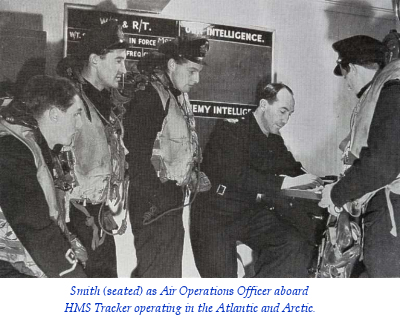 A pilots course was not open to RAN officers at the time, as
from the end of WW1 until 1947 the Royal Australian Air
Force supplied the aircraft, pilots and maintainers for the
Seagull/Walrus amphibians on RAN ships – an unsatisfactory
situation that in later years led to the formation of the
RAN Fleet Air Arm. So, in the 1930s, if you wanted to
specialise in naval aviation you became an Observer.
He later said he became an aviator because he thought naval
air power would become crucial to national defence. He
also recalled that his first five training flights ended in
forced landings. A pilots course was not open to RAN officers at the time, as
from the end of WW1 until 1947 the Royal Australian Air
Force supplied the aircraft, pilots and maintainers for the
Seagull/Walrus amphibians on RAN ships – an unsatisfactory
situation that in later years led to the formation of the
RAN Fleet Air Arm. So, in the 1930s, if you wanted to
specialise in naval aviation you became an Observer.
He later said he became an aviator because he thought naval
air power would become crucial to national defence. He
also recalled that his first five training flights ended in
forced landings.
The Observers course was about seven months and on
completion Smith joined HMS Victory for a few weeks
before being appointed to HMS Glorious finishing a
refit at Portsmouth, then proceeding to the Mediterranean at
the beginning of 1938.
At the end of August 1939 Smith left HMS Glorious
to attend a meteorological course in England, to be followed
by his return to Australia. Because war was declared
on 3 September 1939 the Met course was cancelled and he was
sent north to Scapa Flow to join 821 Squadron on HMS Ark
Royal. It was off to war – and no return to
Australia.
When the German battlecruiser Scharnhorst and its
large escort were discovered sailing south along the coast
of Norway, 821 Squadron’s Swordfish aircraft were ordered to
attack. On 21 June 1940, under the command of LEUT
Smith, six Fairey Swordfish, with long range tanks fitted,
flew across the North Sea and located the German force.
In the face of fierce anti-aircraft fire, a torpedo attack
was carried out by the Swordfish but no hits were scored and
two aircraft were lost. Short of fuel the aircraft
flew to the Shetlands to refuel before returning to RNAS
Hatston. Later the senior pilot and Smith
received Mention in Despatches.
In early 1940, he flew from the Royal Navy’s Air Station HMS
Sparrowhawk in the Orkneys. He was mentioned in dispatches
for his part in a daring raid by six Swordfish biplanes
against the German battleship Scharnhorst, off the Norwegian
coast. Smith then served as Senior Observer in 807 Squadron
flying from HMS Ark Royal in the Mediterranean.
In May and again in September Smith was shot down and on
both occasions (with the pilot) was rescued by a destroyer. On
one occasion, he saved the life of his wounded pilot by
keeping him afloat while waiting for rescue. Smith was still
in Ark Royal when the carrier was torpedoed by a U-Boat and
sank off Gibraltar.
At the end of 1941 Smith was awarded a Distinguished Service
Cross for:
‘outstanding zeal, patience and cheerfulness, and
for setting an example of whole-hearted devotion to duty.’
He returned to Australia in 1942 to liaise with the US Navy
before being posted to Canberra again. He was aboard the
cruiser when it was set ablaze by Japanese cruisers in the
battle of Savo Island, during the Guadalcanal landings.

In 1943 Smith served firstly in the cruiser HMAS Shropshire,
then the aircraft carrier HMS Tracker which was escorting
Arctic convoys to Russia. Promoted to Lieutenant
Commander in 1944, Victor Smith was appointed as the Air
Planning Officer on the staff of the Flag Officer, British
Assault Area for ‘Operation Neptune,’ part of ‘Operation
Overlord,’ for the invasion of Normandy. He joined
FOBAA’s staff in April 1944 engaged in ‘Operation Neptune’
planning and liaising with other forces that were
cooperating with the Royal Navy. In the early hours of
6 June 1944, along with many other ships, the staff arrived
at the coast of Normandy and after several days they moved
ashore where Smith continued working with senior Army and
RAF officers. The main naval requirement was for the
protection of shipping in the Channel and near the beaches.
Witnessing tactical air
power in use during Operation Neptune was an experience
which shaped his strategic vision. Smith said that D Day
impressed him with the versatility of naval force and the
importance of harmonious work between the three services.
In September 1944 LCDR Smith was recalled to England to work
with the Admiralty to plan the shore facilities for the RN
Fleet Air Arm branch of the British Pacific Fleet (BPF),
which was due to arrive in Australia in November 1944.
This was valuable experience as Smith soon transferred to
Vice Admiral (Q’s) staff in Melbourne for air planning
duties; (Q) was an Army term adopted to cover naval
logistics in all its aspects.
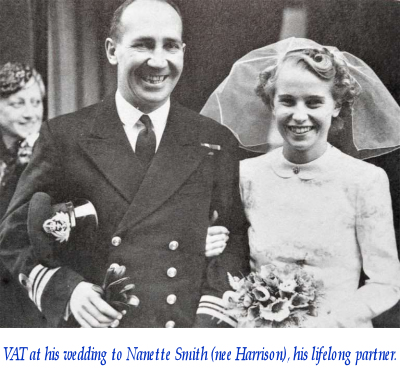 The time in England before and after the Normandy landings
gave Smith the opportunity to meet, court and marry Miss
Nanette Susan Harrison. For that reason, he was always
thankful the Normandy appointment came his way. The
couple were engaged in September 1944 and when he was told
on 23 October he would be leaving for Australia in 10 days,
he phoned Nanette and asked if they could be married the
following Saturday. With five days’ notice they were
married, then following a brief honeymoon he left for
Australia. They did not meet again until late 1945,
when he returned to England to gather details for the RAN
Fleet Air Arm plan. The time in England before and after the Normandy landings
gave Smith the opportunity to meet, court and marry Miss
Nanette Susan Harrison. For that reason, he was always
thankful the Normandy appointment came his way. The
couple were engaged in September 1944 and when he was told
on 23 October he would be leaving for Australia in 10 days,
he phoned Nanette and asked if they could be married the
following Saturday. With five days’ notice they were
married, then following a brief honeymoon he left for
Australia. They did not meet again until late 1945,
when he returned to England to gather details for the RAN
Fleet Air Arm plan.
At war's end he was on the staff of the Vice Admiral British
Pacific Fleet. His abiding lesson from his war at sea was
that a Navy needed its own tactical air power. Smith wanted
to see a post war RAN Fleet Air Arm that was ‘Second to
None’. In 1946 he was sent to London to assist with planning
the RAN’s future Fleet Air Arm. The two carrier plan he
helped devise was approved by the Chifley Government in 1947
and was implemented.
He was promoted to Commander in 1947 and his operational
service resumed as Executive Officer in the aircraft carrier
HMAS Sydney, then flying Firefly and Sea Fury aircraft, in
the Korean War in 1951.
He was promoted Captain in 1953 and later commanded the
First Frigate Squadron. He then commanded HMAS Albatross,
the Naval Air Station at Nowra, from 1957 to 1959.
This appointment was very special as Smith did a lot of the
planning for Nowra, as a base for the British Pacific Fleet
FAA in 1944-45, and so it was satisfying to come back as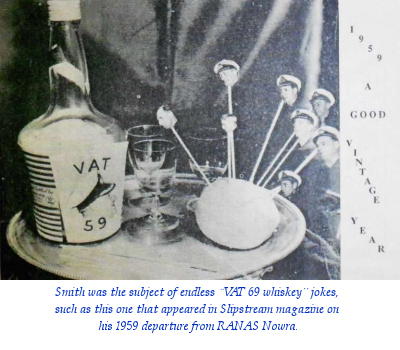 Captain of the RAN Air Station 12 years later.
Albatross was very busy, in addition to the front-line
squadrons being active when disembarked from Melbourne,
second line squadrons were training, with some using Jervis
Bay strip. Training for Observers, Aircraft Handlers,
Safety Equipment workers and Air Mechanics was at full pace.
With the Australian Joint Anti-Submarine School (AJASS) as a
lodger unit at the air station.
Captain of the RAN Air Station 12 years later.
Albatross was very busy, in addition to the front-line
squadrons being active when disembarked from Melbourne,
second line squadrons were training, with some using Jervis
Bay strip. Training for Observers, Aircraft Handlers,
Safety Equipment workers and Air Mechanics was at full pace.
With the Australian Joint Anti-Submarine School (AJASS) as a
lodger unit at the air station.
Smith said his almost three years in command at
Albatross was satisfying with a great deal achieved in
training and the introduction of new Sea Venom and Gannet
aircraft. In 1959 Rear Admiral Harries did an
inspection and reported that the Air Station was ‘a
shining example of the Service at its best.’ An unusual duty was when
the NSW Government sacked the Shoalhaven Council, which led
to Smith being asked to act in the absence of a Council
President at civic events and functions – helping
Albatross and the Council to become closer than before.
On leaving Albatross in November 1959 the Council
gave Captain Smith and Nannette a civic farewell.
At the end of 1959 Smith and his family sailed to Britain on
SS Dominion Monarch, where he enrolled at the
Imperial Defence College (later Royal College of Defence
Studies) on 5 January 1960. His time at the IDC
provided a rare opportunity for academic study and to
participate in study tours, and to mix with senior officers
from different services and countries.
At the end of 1960, on completion of the IDC course, Smith
was pleased to learn his next appointment would be at sea,
from 8 January 1961, as Captain of the Flagship HMAS
Melbourne and Chief Staff Officer to the Flag Officer
Commanding the Australian Fleet. It was a welcome role
as Smith had served on Sydney and several RN aircraft
carriers. In 1961 and 1962 Melbourne sailed north to
participate in international exercises and visit Southeast
Asian ports. These cruises were successful although
following one exercise Melbourne developed shaft
trouble which was rectified at Hong Kong. A similar
experience to that on Sydney as both ships did a
lot of high speed steaming which they stood up to very well.
Smith said sailing through the Inland Sea of Japan at night
was a challenge due to the large number of fishing boats.
Another challenge was when tug boats and wharfies
blackballed Melbourne during a visit to Auckland,
refusing to assist on the ship’s departure. Smith’s
answer was to line up the Gannets and Sea Venoms on the
flight deck and with engines revving to ’pinwheel’ the ship
away from the wharf – then to sail down the harbour with the
band playing the ‘Maoris Farewell’. Obstacles were
never a problem for Smith, when Melbourne’s
catapult became unserviceable, rather than cancel an
exercise, he ordered the Gannets to ‘range aft’ for free
take-offs along the flight deck centreline. Nervous
pilots consulted their handbooks, but soon found the Gannets
airborne after passing the ship’s island, well before
reaching the bow.
After 18 months Smith’s command of Melbourne
finished on 16 June 1962. This ended his direct
connection with the RAN Fleet Air Arm which contained only
two breaks – in 1956 with the Frigates and in 1960 at the
IDC – since writing the draft plan for the RAN Fleet Air Arm
in 1945.
On 6 July 1962 Smith was appointed Second Naval Member of
the Australian Naval Board and promoted to Acting Rear
Admiral, confirmed in January 1963; and in the same year
made Commander of the Order of the British Empire – with
continuous service as Fourth Naval Member throughout 1965.
On 10 January 1966 his next appointment was Flag Officer
Commanding the Australian Fleet with HMAS Melbourne as his
Flagship, assuming duty on 28 January 1966.
In January 1967 he joined Navy Office as Deputy Chief of
Naval Staff and in June was made a Commander of the Order of
the Bath. On 15 November 1967 he was promoted to
Vice Admiral and made First Naval Member of the Commonwealth
Naval Board.
In April 1968 he was appointed Chief of Naval Staff,
promoted to the rank of Vice Admiral and made a Companion of
the Order of the Bath. He wrote of his work preceding
this appointment:
‘I had great fortune in three ways. Firstly by being
selected CNS, secondly having had experience as Second and
Fourth Naval Member, and thirdly moving into the CNS
position from that of Deputy Chief of Naval Staff.’
With his breadth of tactical, operational, command and
administrative experience Smith’s promotion to Vice Admiral
and his appointment as CNS was widely seen as a logical
step. He saw his role as that of being a problem solver for
Government:
‘The fundamental problem we have to face is how to maintain
the security of the country and meet the commitments
overseas into which the Government has entered.’
On assuming command of the RAN he released a signal to the
Navy which read:
‘On assuming this posting I would like everyone to know that
I regard myself as the Captain of a team in which everyone
in the RAN is a member. The best results come not from the
efforts of some individuals but from the united efforts of
everyone. I believe that we must remember that it is upon
the RAN that the wealth, safety and strength of Australia so
greatly depends.’
When in May 1969 the newly refitted Melbourne took her full
complement of Skyhawks and Trackers to take part in a SEATO
Exercise the RAN had reached a high water mark for its
peacetime strength of ships and submarines in commission and
building. One month later, 650 miles south west of Manila on
the night of 3 June, Melbourne collided with and cut in half
the destroyer USS Frank E Evans. Seventy four American lives
were lost.
As soon as it became clear that this was a major accident,
with significance for both navies, Smith contacted his USN
counterpart and proposed a joint fact-finding Board of
Inquiry. Smith took this initiative not only because it was
the correct legal response to the collision, but also to
head off other possible enquiries. Smith was particularly
concerned at the prospect of the tragedy being investigated
by a Royal Commission in Australia as had occurred in 1964
when Melbourne collided with Voyager. By quickly convening
an inquiry of this form he created the means by which the
facts of the case could be established.
Smith was made a Knight Commander of the Order of the
British Empire (KBE) in 1969. Then in September 1970 it was
announced that Sir Victor was to become Chairman of the
Chiefs of Staff Committee. This last step in Smith’s career
included his promotion to full Admiral, the first Royal
Australian Naval College graduate to achieve the rank. In
his final CNS message to the RAN Smith said:
‘I leave the Navy entirely satisfied that the future is in
good hands. You are a very great team with a great future. The USN regards our sailors as being complete professionals
capable of performing any task efficiently. It is reasonable
to say that an efficient Navy is a deterrent to any country
that might consider attacking Australia.’
As Chairman of the Chiefs of Staff Committee for five years
until November 1975, Smith quickly became tri-service in
outlook and orientation, as the job required. He said his
new motto was very simple, it was – Convince Me.
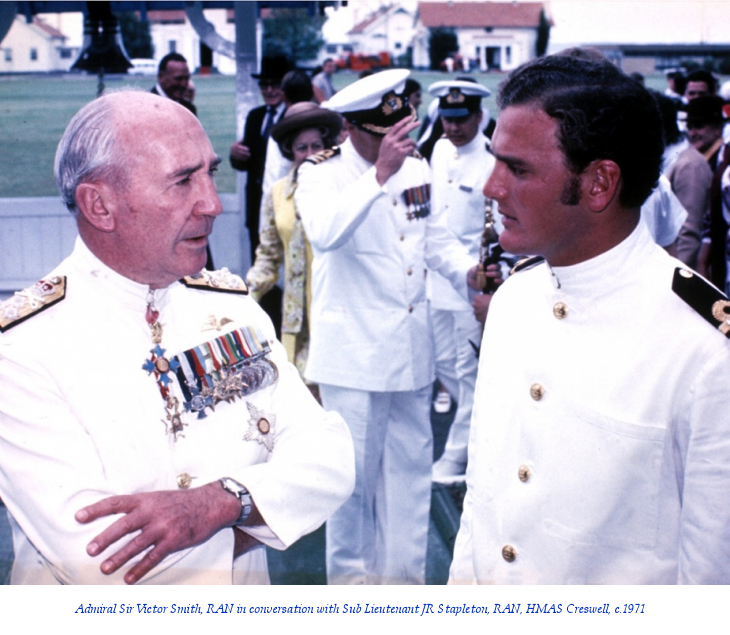
Smith’s term as CCSC was a turbulent period which included
withdrawal from Vietnam, the effective end of SEATO and
American adoption of the ‘Guam Doctrine’. In Australia, the
defeat of the Liberal-Country Party coalition and Labor’s
accession to government at the end of 1972 meant profound
changes in both strategy and in the organisation of Defence. Smith played a supporting role in the restructuring of
Defence. Championed by the Departmental Secretary, Sir
Arthur Tange, the reforms came into full effect shortly
after his retirement. In 1975 he was made a Companion
of the Order of Australia in the Military Division and on 23
November 1975 he retired after almost 49 years’ service.
Sir Victor Smith retained his interest in the Navy and in
Defence policy throughout his years of retirement. He
usually refrained from public comment, but when the new
Hawke Labor Government in 1983 decided that there would be
no replacement for the RAN’s last aircraft carrier Melbourne
and no need to retain naval fixed wing aircraft he joined
three other ex-CNS in a public letter which criticised the
decision.
He also supported many worthy causes such as President of
the ACT/Queanbeyan Division of Birthright, an Australia-wide
organisation which assists single parents with dependent
children, and as patron of the ACT Rugby League. He
was also the Patron of the Fleet Air Arm Association of
Australia for many years. He is remembered by those
who served with him, for his drive for excellence in naval
aviation, and his concern for the welfare of all those under
his command. He was a great Australian and a credit to
the nation.
Smith died in Canberra in July 1998. His obituary
in The Sydney Morning Herald concluded:
‘He will be remembered as a leader who cared about people,
particularly his men and their families. His bravery and
dedication to duty cannot be faulted. He always inspired and
expected the very highest standards of conduct from himself
and those he commanded.’
Lady Nanette Smith survived her husband by 19 years, passing
away on 17 October 2017. She remained a staunch
supporter of the Fleet Air Arm for the whole of her life and
was sharp to the end. She was survived by her sons
Mark and Piers, and their extended families.
A typhoon tale
Smith had gravitas and a commanding presence, yet
he projected a disciplined calm, which included a sense of
humour as the following suggests. In 1961 when he was
captain of HMAS Melbourne the ship visited Hong
Kong. During the stay Melbourne had to leave
harbour at short notice due to an approaching typhoon.
While most of the crew returned from leave before the ship
sailed some did not make it. This included a sailor by
the name of Johnson (a bit of a character) who during
liberty hired a sampan to sail around the harbour. On
each occasion Johnson went by Melbourne, he sounded
a salute on his Bosun’s pipe. Remarkably – in the time
honoured naval fashion Melbourne returned the
salute – calling the ship’s company to attention. A
week or so later during Divisions, Smith’s eye met that of
‘Captain’ Johnson. He said: “Tell me Captain – as one
Captain to another – how did you weather the typhoon?”

Admiral Sir Victor Alfred
Trumper Smith's medals are currently on display at the Fleet
Air Arm Museum, NAS Nowra
Sources:
LCDR Desmond Woods RAN
Fleet Air Arm Association of Australia - Father of the Fleet Air Arm
Naval Historical Society of Australia
Sea Power Centre Australia
|
